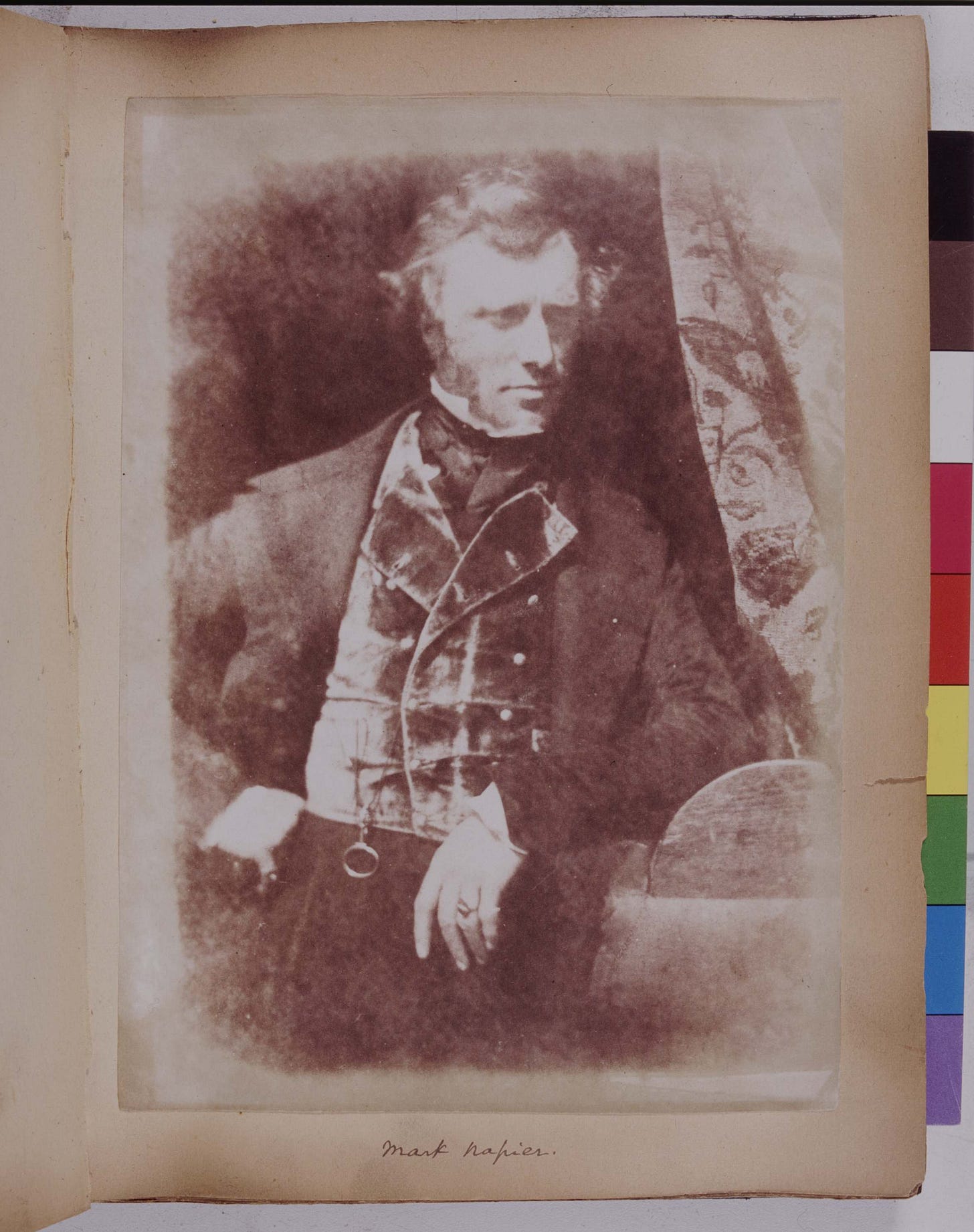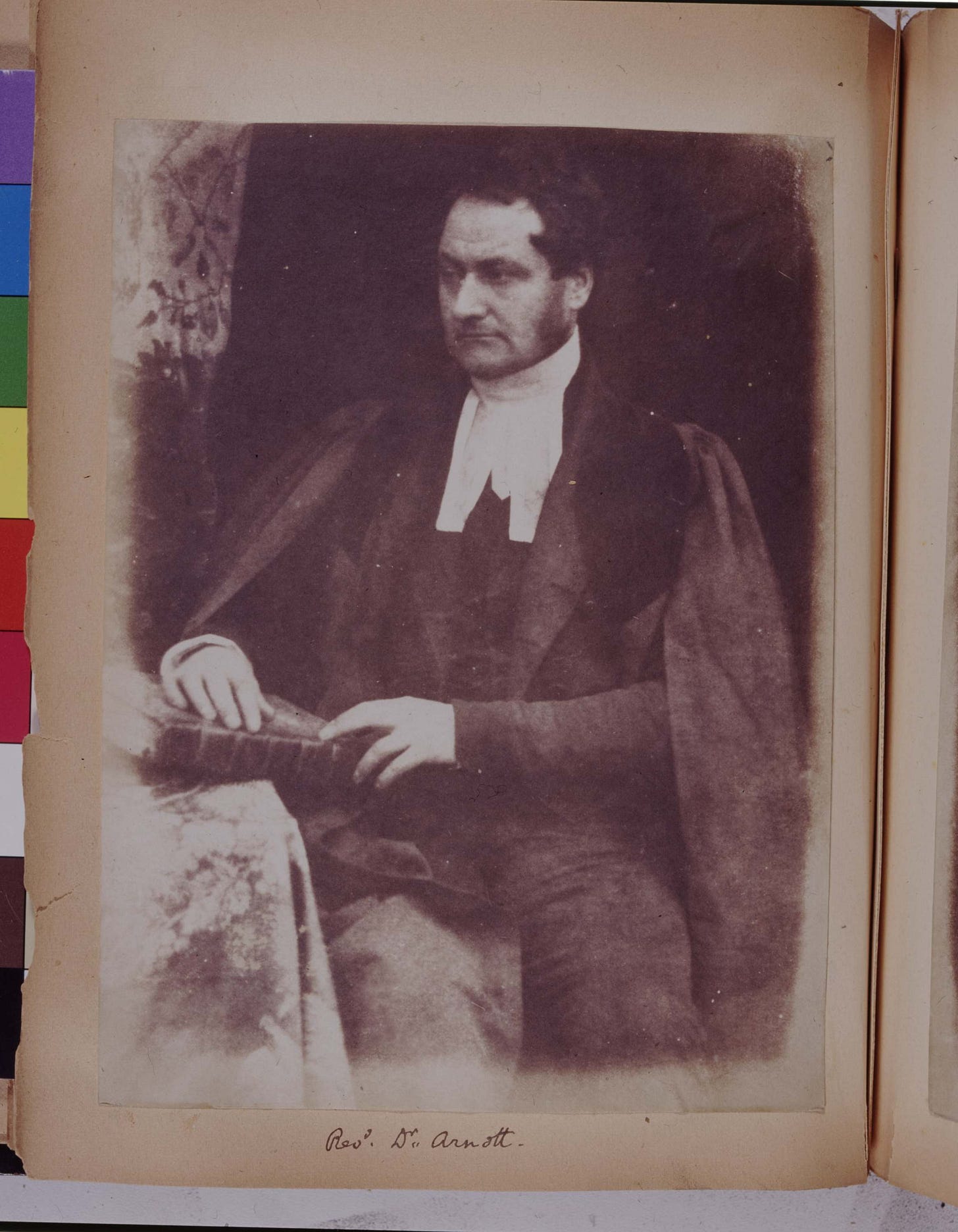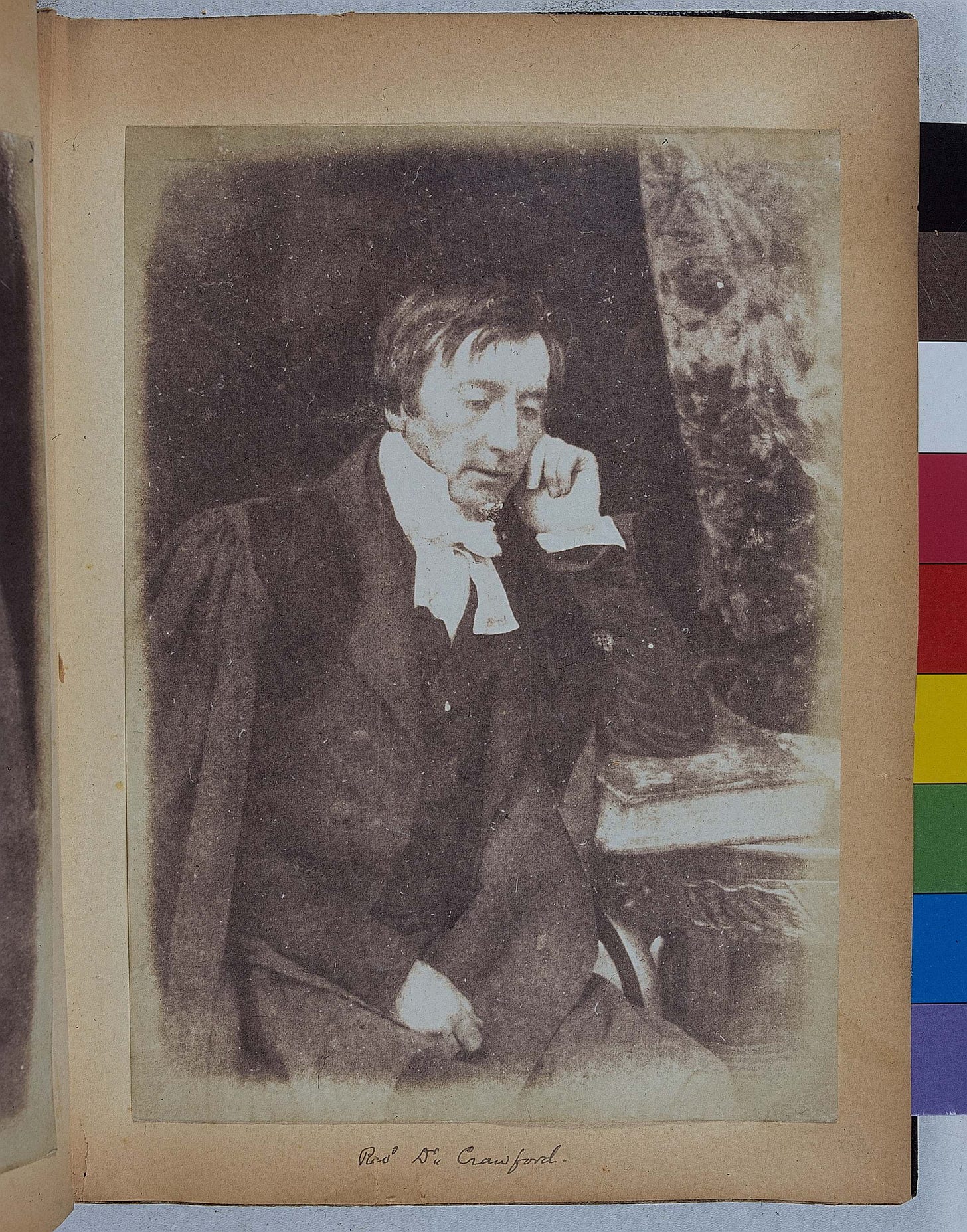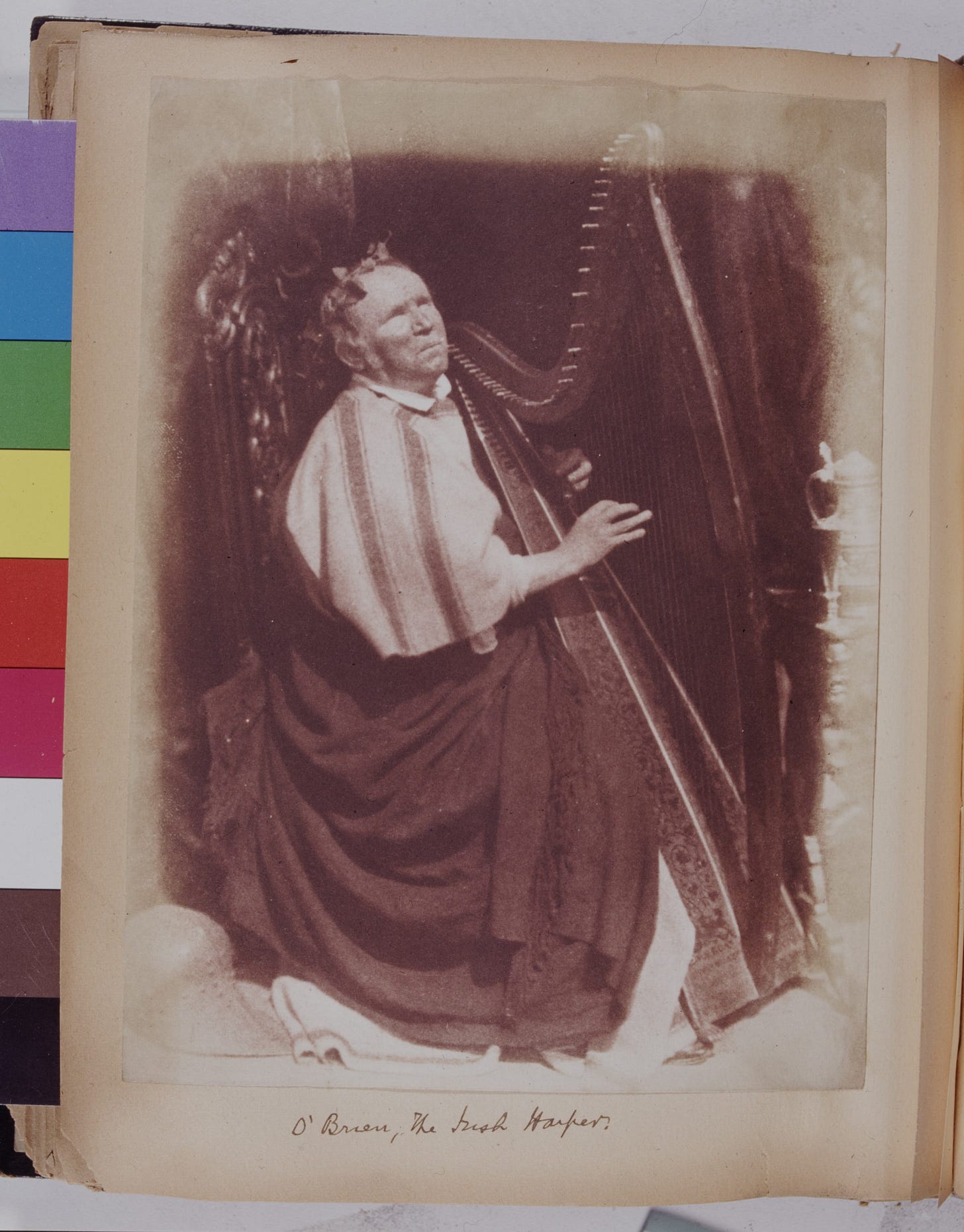Hill, Mann and Adamson: The Mitchell Album NRS GD492/62
The Mitchell Album is a volume of Hill, Mann and Adamson salt prints owned by the Signet Library/ The Society of Writers to HM Signet in Edinburgh which is on deposit at the National Records of Scotland at NRS GD492/62. The album also contains carbon prints of the partnership’s work, and a small number of images by other photographers. It’s an excellent example of the deliberate nineteenth century collecting of work by the Hill, Mann and Adamson partnership and potentially holds evidence to the reception of the work in the decades following Adamson’s 1848 death and the end of the partnership.
Hill, Mann and Anderson
Hill, Mann and Adamson (the Mann being Jessie Mann, the assistant to Robert Adamson and David Octavius Hill who is thought to have been the first Scottish woman to take a photograph ) were a partnership that initially formed to take calotypes of participants in Scotland’s 1843 Disruption of the Church. Their photography is now known and admired throughout the wider art world in which they are commonly regarded as the pioneers of art photography. Their portraits of the Newhaven fisherfolk are familiar to people far beyond art enthusiast circles. The partnership was brief, ending with Robert Adamson’s death early in 18481.
Provenance
The album was compiled by the great Scottish psychiatrist and antiquarian of the Victorian era, Sir Arthur Mitchell (1826-1909). The title page is inscribed “Photographs by D. O. Hill RSA” in Sir Arthur Mitchell’s handwriting, and the same handwriting is used to caption some, although not all, of the images. It formed part of a large bequest to the Signet Library of books, papers, scrapbooks and albums that followed the death in 1930 of the Signet Library’s architect, Sir Arthur’s son Sidney Mitchell, builder of the Library’s 1900-1902 West Wing Extension. The Signet Library placed the bequest on deposit at the National Records of Scotland in 19952.
Sir Arthur Mitchell3 was born in Elgin and educated there and at the University of Aberdeen before studying abroad in Paris, Berlin and Vienna. With the passing of the Lunacy Act of 1857 Mitchell took on in succession the Deputy Commissioner and Commissioner roles that would define his professional career. In 1864 his work The Insane in Private Dwellings was published and this went on to form the basis of a system of care for the mentally ill in private homes that was unique to Scotland. He would serve in a similar role in England and Ireland, and between 1867 and 1871 was the Morison Lecturer at the Royal College of Physicians. He was knighted in 1887.
Outwith the professional sphere Mitchell was an archaeologist and historian, a leading figure in the Society of Antiquaries of Scotland. One obituary described him as ‘the last of the little band of eminent men—Joseph Robertson, Cosmo Innes, W. F. Skene, and David Laing on the historic side, and Daniel Wilson, John Stuart, Sir James Simpson, John Alexander Smith, Captain T. W. L. Thomas, and himself on the side of antiquities – whose work and influence did so much to stimulate the progress of the Society and settle its aims and methods on the basis of true science’4.
He was the first Rhind Lecturer of the Society and his lectures (published in 1880 as The Past in the Present5, an exploration of the transformed afterlife in tradition and superstition of the formerly everyday) would prove enduringly influential. A pair of lines from the lectures – ‘When the cripple who can see mounts the strong back of his brother who is blind, they make together a man who can see and walk, and so they can both accomplish the journey which to each separately is impossible. In this little society of two we see that happening, in a small and simple way, which presents itself, with much complication, in large associations of men’ – formed the basis for the design on his bookplate6.
The Mitchell materials bequeathed to the Signet Library included the papers of Dr John Jardine (1715-1766), the Minister of Liberton whose collection of materials and first hand accounts of the 1745 Rebellion is one of the most important historical sources for the period7. The bulk of the bequest however consists of notebooks, scrapbooks and albums related to Sir Arthur Mitchell’s antiquarian interests and travels. This includes a significant number of albums of photographs, which demonstrate an appreciation on Mitchell’s part of photography as a tool of antiquarian record but also as a focus of collecting interest in its own right: the 13 albumen prints contained in NRS GD492/17 include an example of Thomas Annan’s late 1860s salt prints of Glasgow slum housing8.
The Mitchell Album: Description
GD492/62 (“The Mitchell Album”) contains 64 images that can be identified as the work of Hill and Adamson, in addition to two further images which the NRS regard as works by unidentified photographers and inserted by Mitchell. Three of the images appear to be carbon prints, with the remainder being salt prints. The prints are in excellent condition although the album itself is no longer in a state to allow regular handling (a fresh set of digital images of the album were made for the purpose of this analysis). Page 23 of the album holds two salt prints, but otherwise each print occupies its own individual page.
Most of the images are portraits. One interesting exception is on page 4 of the album, a carbon print of Stevenson St. Andrews 36 North Street Fishergate Women and Children Bait the Lines. This bears the erroneous caption ‘A Street in Newhaven’ in Mitchell’s handwriting.
The portrait of Maitland Macgill Crichton on page 25 may be a unique example (no negative and no further salt or carbon prints have been traced), although the picture was clearly taken on the same occasion as the other surviving Hill and Adamson portraits of Crichton.
There are basic groupings of images within the album: the trio of Newhaven images are arranged together, as are the pair of Greyfriars prints: portraits of women, of children, and of individuals in costume are also grouped.
The album is difficult to date with accuracy. Mitchell’s engagement with photography may have begun as early as the 1870s, although the bulk of his albums and scrapbooks have been given dates in the 1880s or later by NRS cataloguers. The caption to image 60 of William Leighton Leitch records his date of death (1883) in Mitchell’s handwriting although the dates may have been added in later.
The presence of the carbon prints may indicate a date at the beginning of the 1880s, when Thomas Annan is known to have been engaged in producing carbon prints from what James Craig Annan described (in a 1945 letter to Helmut Gernsheim now at the Harry Ransom Center) as ‘collodion contratype negatives’ made from Hill, Mann and Adamson calotypes. They do not appear to be from the carbon prints produced by Jessie Bertram at her studio on Edinburgh’s Rose Street between 1914 and 1926.
Indeed, the portrait of George Combe (page 6 of the album) is a mirror image of Stevenson George Combe b and very notably this carbon print takes the same form as that published posthumously by Andrew Elliot in 1928 in Calotypes by D.O. Hill and R. Adamson : illustrating an early stage in the development of photography (Edinburgh : printed for private circulation, 1928). This is useful additional evidence for the prints in Elliot’s pioneering book - the first dedicated to the partnership - emanating from the Annan studio on Edinburgh’s Calton Hill as claimed by James Craig Annan9 and not from that of Jessie Bertram.
The Mitchell Album: Image Analysis
The National Records of Scotland team attempted to identify each of the images at the time of deposit, but this analysis has attempted a fresh identification of each image based on Sara Stevenson’s David Octavius Hill and Robert Adamson: Catalogue of their Calotypes Taken Between 1843 and 1847 in the Collection of the Scottish National Portrait Gallery (Edinburgh: Trustees of the National Galleries of Scotland, 1981), and on identifications made from the now-expanded collections at the Scotland National Galleries and the University of Glasgow.
Where an image is to be found in Stevenson the reference is given in bold and where an image is present in the Dougan and other collections at the University of Glasgow but absent from Stevenson the University of Glasgow reference is given in bold with the suffix GUL.
1. Title page ‘Photographs by D. O. Hill RSA’ (in hand of Sir Arthur Mitchell)
2. 'Professor Andrew Fyfe' (caption by Mitchell) – possibly a (previously unknown) likeness of the chemist Andrew Fyfe whose series of papers before the Society of Arts for Scotland, in which he examined the chemistry of Talbot's process, give him at least a claim to be the inventor of positive photographic prints. Not in Stevenson and NRS regard this as one of two prints not by Hill and Adamson inserted by Mitchell.
3. 'Mrs Capt. Grant'(caption by Mitchell). A Mrs. Captain Grant was listed in Gray’s Annual Directory of Edinburgh for 1832-33 at 11 Brandon Street; but not in Stevenson, and NRS do not regard this as a Hill and Adamson print.
4. 'A Street in Newhaven' (caption by Mitchell) – this carbon print is in fact Stevenson St. Andrews 36 North Street Fishergate Women and Children Bait the Lines. Stevenson St Andrews 35, the companion to this image, is contained in the Signet Library copy of Hill and Adamson’s Series of Calotype Views of St. Andrews.
5. No Mitchell identification, but this is Stevenson Dr Thomas Chalmers h, the most common of the Stevenson Chalmers images by Hill, Mann and Adamson (carbon print).
6. ‘George Combe’ (Caption by Mitchell) George Combe, Writer to the Signet, educational reformer and pioneer of phrenology. This would appear to be a mirror image of Stevenson George Combe b (notably this carbon print takes the same form as that published posthumously by Andrew Elliot in 1928 (as per the National Portrait Gallery (London) copy).
7. ‘Sir John McNeill G.C.B.’ (Caption by Mitchell) Stevenson Sir John McNeill c
8. ‘James Naismith – engineer’ (caption by Mitchell) Stevenson James Naysmith b
9. ‘Sir David Brewster’ (caption by Mitchell) Stevenson Sir David Brewster a
10. ‘Robert Liston, Surgeon’ (caption by Mitchell) Stevenson Robert Liston b
11. ‘Sir Culling Airdley (? Eardley) –’ (caption by Mitchell) Stevenson Sir Culling Eardley Smith b
12. ‘Mark Napier’ (caption by Mitchell) Stevenson Mark Napier c
13. ‘Revd. Julius Wood’ Stevenson Rev. Dr. James Julius Wood a(1)
14. ‘Professor Fraser’ (caption by Mitchell) Stevenson Professor Alexander Campbell Fraser a
15. ‘Lord Ruthven’ (caption by Mitchell) Stevenson James Lord Ruthven a
16. ‘Mr. Rintoul, Editor of Spectator’ (caption by Mitchell) Stevenson Robert Stephen Rintoul b
17. ‘Revd. Dr. Arnott’ Stevenson Rev Dr David Arnott
18. ‘Revd. Dr. Crawford’ (caption by Mitchell) Stevenson Professor Thomas Jackson Crawford b
19. ‘Captain Etty’ (caption by Mitchell) Stevenson Captain Charles Etty a
20. ‘Mr. Henning & Mr. Handiside Ritchie’ Stevenson Group 126 John Henning and Alexander Handyside Ritchie
21. ‘Sheriff Speirs’ (caption by Mitchell) Stevenson Robert Cunningham Graham Speirs
22. ‘Wm. Etty – R.A.-’ (caption by Mitchell) Stevenson William Etty a
23. ‘Samuel Aitken, Bookseller’ (caption by Mitchell) Stevenson Samuel Aitken b; ‘Thomas Duncan & His Brother’ (caption by Mitchell) Stevenson Group 88 James and Thomas Duncan
24. ‘Dr Knox’ Stevenson Dr. Robert Knox b
25. ‘Maitland MacGill Crichton’ (caption by Mitchell) NOT IN STEVENSON and no other print or negative traced, but related to Stevenson David Maitland Makgill Crichton d
26. ‘Dr. Chalmers’ (caption by Mitchell) Stevenson Rev Dr. Thomas Chalmers f
27. ‘Mr. Hamilton, Advocate’ (caption by Mitchell) NOT IN STEVENSON but salt print at GUL HA0117 and related to Stevenson John Hamilton a
28. ‘Thomas Duncan R.S.A’ Stevenson Thomas Duncan b
29. ‘James Blackie, Jn, Publisher, Glasgow’ (caption by Mitchell) Stevenson John Blackie a
30. ‘Revd. [illeg] Jaffray & Daugheboy’ (caption by Mitchell) Stevenson Group 146 Rev John Jaffray & Dhanjiobai Nauroji
31. ‘Sir W Allan, P.R.S.A’ (caption by Mitchell) Stevenson Sir William Allan c
32. ‘Lord Robertson’ (caption by Mitchell) Stevenson Patrick Lord Robertson a
33. ‘Kenneth Macleay’ (caption by Mitchell) Stevenson Kenneth Macleay a
34. ‘Wm Henning, Artist’ (caption by Mitchell) Stevenson John Henning c
35. ‘Hon James Stuart Wortley and Lady’ (caption by Mitchell) Stevenson Group 269 John Stuart-Wortley, Baron Wharncliffe and Georgina, Baroness Wharncliffe
36. ‘Sheriff Munro’ (caption by Mitchell) Stevenson Group 196 George Monro and Mrs Justine Gallie
37. ‘Dr. George Bell’ (caption by Mitchell) Stevenson Group 35 Dr George
Bell, Alexina, Lady Moncrieff and Rev Thomas Bell
38. ‘Mrs Watson’ (caption by Mitchell) Stevenson Mrs Mary (Hill) Watson c
39. ‘Mrs Jamieson’ (caption by Mitchell) Stevenson Mrs Anna (Brownell Murphy) Jameson
40. ‘Misses Binnie and Miss Munro’ (caption by Mitchell) Stevenson Group 37 Misses Binney and Mrs Justine Gallie
41. ‘Miss McCandlish’ (caption by Mitchell) Stevenson Miss McCandlish, later Mrs. Rishton a
42. ‘Mrs Bell’ (caption by Mitchell) Stevenson Mrs Isabella Morrison (Adamson) Bell
43. ‘Mrs & Miss Rigby’ (caption by Mitchell) Stevenson Group 221 Mrs Anne Rigby and Lady Elizabeth Eastlake
44. ‘Miss Rigby’ (caption by Mitchell) Stevenson Lady Elizabeth (Rigby) Eastlake c
45. ‘Miss Rigby – Lady Eastlake’ (caption by Mitchell) Stevenson Lady Elizabeth (Rigby) Eastlake n
46. ‘Miss Matilda Rigby’ (caption by Mitchell) Stevenson Mrs Matilda (Rigby) Smith b
47. (No Mitchell caption) Stevenson Lady Elizabeth (Rigby) Eastlake m
48. (No Mitchell caption) Stevenson Miss Barker a
49. (No Mitchell caption) Stevenson Lady Elizabeth (Rigby) Eastlake i
50. ‘Newhaven Fisherman’ (caption by Mitchell) Stevenson Newhaven 45 3 Unknown Boys and James Linton
51. ‘Newhaven Fishwife’ (caption by Mitchell) Stevenson Newhaven 13 Mrs Elizabeth (Johnstone) Hall
52. ‘Newhaven Fishwife’ (caption by Mitchell) Stevenson Newhaven 9 Mrs Barbara (Johnstone) Flucker
53. ‘Girl with doll asleep’ (caption by Mitchell) Stevenson Miss Bell (2) c
54. (No Mitchell caption) Stevenson Group 117 Misses Grierson
55. (No Mitchell caption) Stevenson Mrs Anne (Palgrave) Rigby h
56. (No Mitchell caption) Stevenson Mrs Anne (Palgrave) Rigby g
57. (No Mitchell caption) Stevenson Group 38 Misses Binney
58. (No Mitchell caption) Stevenson Lady Elizabeth (Rigby) Eastlake j
59. ‘O’Brien, the Irish Harper’ (caption by Mitchell) Stevenson Patrick Byrne b
60. ‘W.L. Leitch, Artist’ ‘1804-1883’ (captions by Mitchell) Stevenson William Leighton Leitch a
61. ‘William Henning as a Gaburlunzie’ (caption by Mitchell) Stevenson Group 128 Mrs Cleghorn and John Henning as Miss Wardour and Edie Ochiltree from Sir Walter Scott’s The Antiquary
62. (No Mitchell caption) Stevenson Art 16 Statue of Sir Walter Scott by Sir John Robert Steele before it was placed in the Scott Monument
63. ‘Marked - “Dunbarton”’ (NRS description) Stevenson Presbytery Group 6 Dunbarton Presbytery
64. (No Mitchell caption) Stevenson Karl Heinrich Sach
65. ‘Greyfriars’ (caption by Mitchell) Stevenson Edinburgh 48 Greyfriars Churchyard, the Dennistoun Monument with D O Hill and his nieces
66. (No Mitchell caption) Stevenson Edinburgh 4 Greyfriars Churchyard, the Martyr’s
Memorial and the McCulloch Monument (with D O Hill and Miss Watson?)
67. (No Mitchell caption) Stevenson Art 21 The Charteris Door from Amisfield
For an excellent recent introduction see Anne Lyden, A Perfect Chemistry: photographs by Hill and Adamson (Edinburgh: Trustees of the National Galleries of Scotland, 2017). Another excellent overview is Sara Stevenson, Facing the Light: The Photography of Hill and Adamson (Edinburgh: Scottish National Portrait Gallery, 2002). More in-depth discussion from both authors and other scholars can be found in the excellent In Focus series volume Hill and Adamson: Photographs from the J. Paul Getty Museum (Los Angeles: The J. Paul Getty Museum, 1999)
The best overview of Sir Arthur Mitchell continues to be the Millar/Andrews entry for him in the Oxford Dictionary of Biography.
Journal of Mental Science 56 (1910) 380
Sir Arthur Mitchell, The Past in the Present: What is Civilisation? (Edinburgh: David Douglas, 1880) Available from the Internet Archive
The design also appears on the title page of The Past in the Present ibid.
The Jardine Papers are National Records of Scotland NRS GD1/1440
For Annan’s work in the Glasgow tenement slums see Sara Stevenson ‘The Books on Glasgow’ in Amanda Maddox, Thomas Annan, photographer of Glasgow (Los Angeles : J. Paul Getty Museum, 2017), Lionel Gossmann Thomas Annan of Glasgow : pioneer of the documentary photograph (Cambridge, Open Book Publishers, 2015) (available online here) and Sara Stevenson, (Edinburgh: National Galleries of Scotland, 1990).
J. Craig Annan to Gernsheim 21 Jul 1945 [Harry Ransom Center]:
"..about 1879 Andrew Elliot in conjunction with my father decided to publish a volume of Hill portraits to be printed in carbon from the original negatives at our Autotype works. Elliot was much more interested in the biographical than the artistic nature of the portraits and put off publishing until he could identify some of the portraits. Meanwhile the prints were made, I can remember, in 1880-1882. Elliot died and was succeeded by his son but he also died and the business went into other hands but a second son a doctor in the South of England got the prints and the printed matter from the cellar had them bound and gave them away - chiefly to libraries."





































































